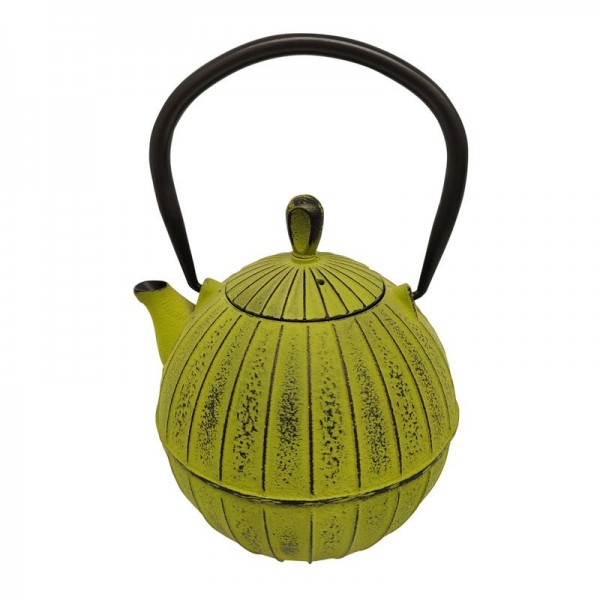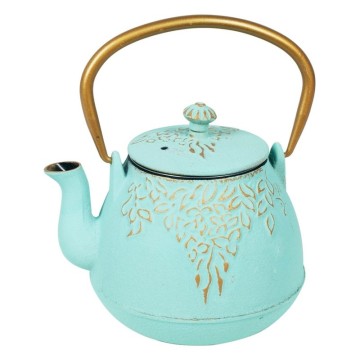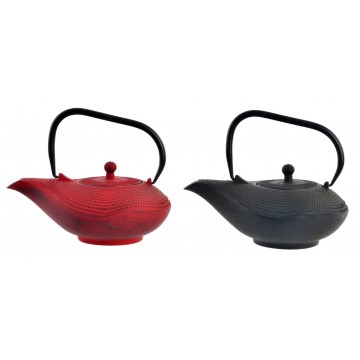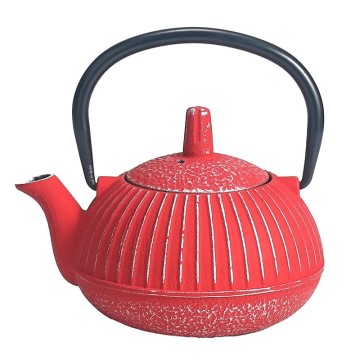The kettle and teapot, with a dual function, represent a fundamental element for the preparation of tea. This model, which refers to the traditional Chinese cast iron teapot, has all the characteristics for the tea ritual. The metal material allows you to maintain the right temperature for boiling and pouring your tea calmly, without the need to heat the water afterwards or keep a hot plate under the teapot. The thermal properties of cast iron (ferrous alloy) are an excellent resource for maintaining internal heat for a long time, in a constant and uniform way. The tea can be kept at the correct serving temperature, and the teapot is suitable for all types of infusions: tea, herbal teas, flower and herb infusions. The kettle has a structure suitable for preparing tea also thanks to the diffuser filter and the lid, which maintains humidity and perfumes making the infusions more aromatic. This teapot is durable and safe with a porcelain enamelled interior to prevent rust. The enamelled coating keeps the taste of the tea intact, because it eliminates the slight porosity of the cast iron and does not retain the memory of the infusions. You will be able to prepare different types of tea, without mixing flavors and aromas. Teapots originated in China and were soon adopted in Japan as well. Both for the preparation of tea as tetsu-kyusu (iron teapot) and as tetsubin, i.e. cast iron kettles that can be put on the fire. This model of Xi'an cast iron teapot can be used both for infusion and for boiling water on induction, glass ceramic, indirect flame gas. It has a capacity of approximately 800 ml, which allows the preparation of approximately 3-4 cups of tea.
The teapot with steel diffuser filter
Loose leaf tea is prepared by best preparing the process of decomposition of the cellular structure of the leaves themselves in boiling water. A procedure that releases the aroma and taste, and for this it must be done correctly. The cast iron teapot is accompanied by a stainless steel diffuser filter, which allows you to welcome and expand the tea leaves. The Inox filter is inserted directly inside, comfortably and safely - stainless steel is a material suitable for food safety - together with the enamelled interior. Thanks to the filter, the loose leaves are infused, aided by the fine mesh of the strainer which retains the small leaves and the minor parts of the herbal teas or infusions to be prepared. In the infusion, the consistency of the ingredients must always be considered, and the very small holes in the strainer help filtering. The diffuser is large, and enhances its function thanks to the round and wide profile of the teapot, which favors the expansion of the leaves in a uniform way. The removable basket shape is useful for removing the leaves after the necessary infusion time has elapsed. The diffuser filter can be used in a simple and intuitive way. If you're only using the cast iron teapot for steeping, place the filter inside and place the tea leaves in the basket. After, pour hot water (preheated with pot or kettle) over it. If you're using the teapot as a kettle, you'll need to fill it with water and bring it to a boil over an indirect flame or other heat source. Remove it from the heat when the water temperature has reached the desired degrees. Then insert the filter with the leaves - the infusion time varies depending on the tea or herbal tea. Once the indicated time has elapsed, remove the removable filter from the teapot.
The oriental design teapot
The decoration of the cast iron in green and black, with decorations in relief, makes the teapot even more elegant and original. The elegance of the tall and oval shape becomes particular with the bright green tone which makes it a design accessory and a notable point of color in the furniture. Its appearance makes your tea breaks and the ritual of pouring and enjoying the hot drink even more refined. The grooves give movement to the surface almost giving the shape of a globe which opens, revealing the scent of the tea or infusion. Green is a vital and bright colour, which evokes nature, enlivened by the "scattered" effects of black and metallic; a decoration that makes this teapot perfect for an elegant tea ceremony for connoisseurs. Create an atmosphere with vintage references, thanks to the traditional charm of Chinese and Japanese cast iron kettles. Round ovoid design, it is thought with a loose shape to spread the loose leaves inside in a wide way. Teapots with a rounded body and narrow base were traditionally used in the Orient to keep the heat longer (the shape minimizes heat transfer). Round and tall teapots are considered ideal for green tea, Oolong, mature Pu-erh, white tea and yellow tea. To make the teapot comfortable to handle, it comes with a wide and tall black handle. Ensures a comfortable grip, to pour hot tea from a distance without burning or dripping. A handle and curved, wide-bore spout allow for proper handling and pouring - without restricting the flow of tea into cups. The lid follows the decoration and shows an elegant black geometric knob, which facilitates the opening and closing movements of the teapot. The metal suggests solidity, while the green makes the teapot lively - perfect for creating a pop of color in a neutral, minimalist space. It goes well with interiors with oriental ethnic furnishings, or with classic wooden interior design. It is a particular accessory in eclectic style interiors that feature metal decorations or accessories, or plant elements. The name is inspired by the Chinese city of Xi'an (also known as Sian), a center with a history of over 3,000 years. It was an ancient capital of China for 13 dynasties, known to Westerners as the eastern end of the famed Silk Road. The green cast iron teapot represents an original accessory for tea service, an extraordinary gift idea for tea and infusion lovers.
How to wash and store your cast iron teapot
Its functionality and beauty are preserved by following rules for washing and maintaining the teapot – in particular to prevent rust from forming. After use, empty the remaining water, let the teapot cool completely.
Rinse by hand in warm water.
Wipe dry with a soft, dry cloth to prevent rust. Wash each part without soap or sponges - they could damage the enamel and the material. Let it air dry without a lid. Always keep the interior dry between uses. If you use kitchen utensils, be careful that they don't scratch the internal enamel. Always check that the inside is well dried, especially the spout. Keep the teapot in a dry place away from moisture and heat.



 By buying this product you can collect up to
By buying this product you can collect up to















